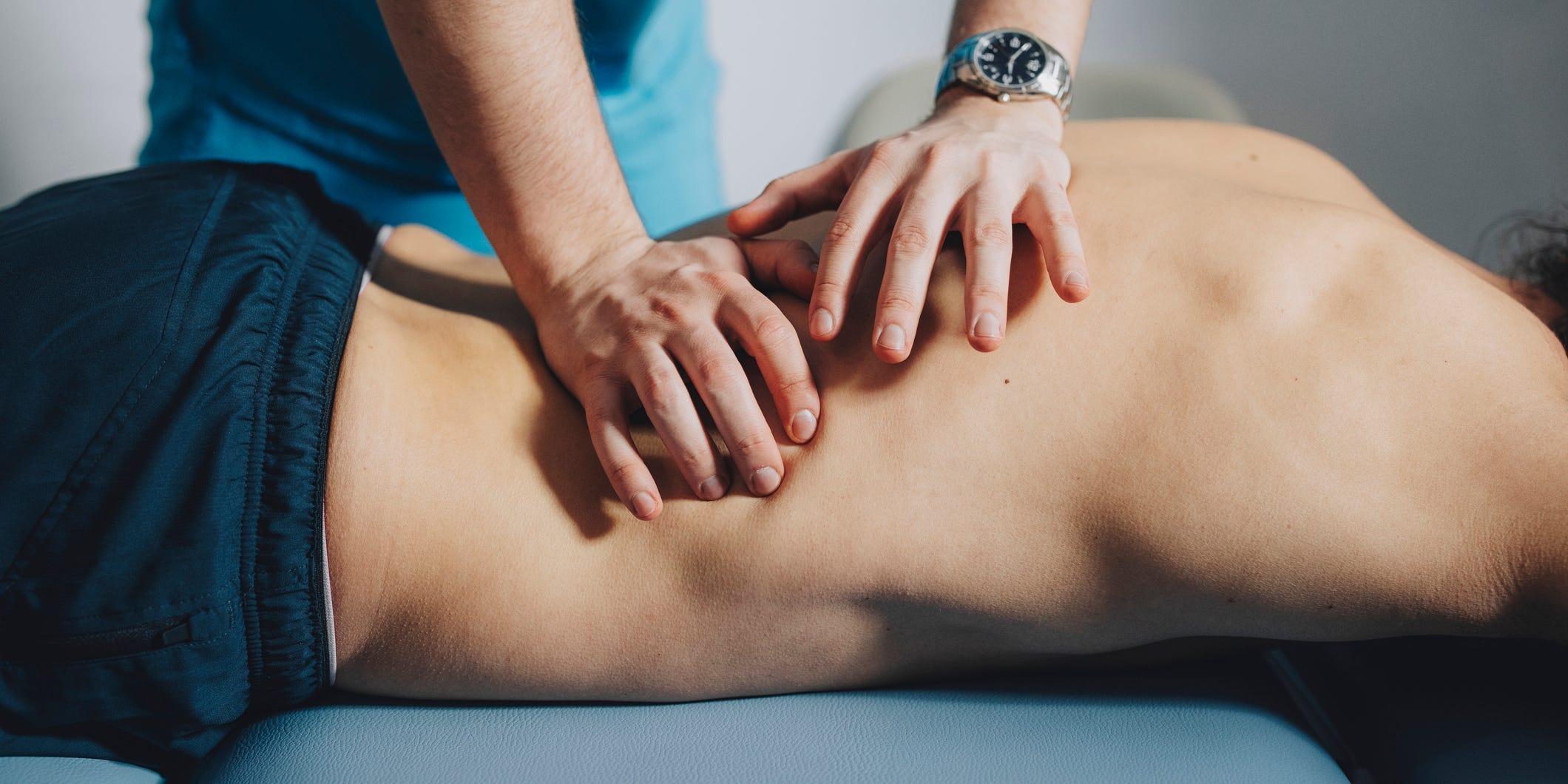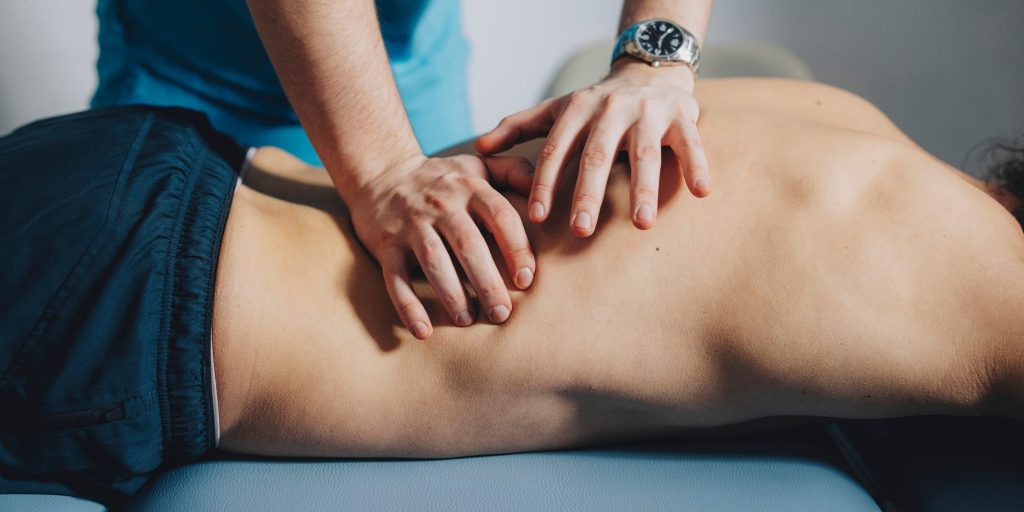
- Low back pain may be an easy fix: Try correcting your posture and exercising regularly, first.
- If that doesn't work, look into physical therapy, massage, and acupuncture.
- If your back pain persists for two weeks, talk to a doctor about your options.
- Visit Insider's Health Reference library for more advice.
Eight out of ten people will experience back pain at some point in their life, and low back pain is the most common.
Low back pain can come in a variety of forms from sharp and stabbing to dull and aching, says Thomas Schuler, MD, a spine surgeon with the Virginia Spine Institute and chairman of the National Spine Health Foundation's Medical & Scientific Board.
A common cause of low back pain is muscle strain resulting from a reduced range of motion in the spine.
Fortunately, Schuler says 90% of patients can find relief through non-operative treatment. Below are five examples of how to relieve low back pain, naturally.
1. Correct your posture
Poor posture can cause pain by increasing strain in your back muscles and placing unnecessary pressure on the lower disks in your spine. Over time, this can ultimately lead to a herniated disk.
For proper posture, have a chair that's the right height so you can comfortably sit with both feet flat on the floor. Make sure your lower back is supported so that you can sit upright with your back against the chair and keep your neck straight.
You may need to adjust the height of your monitor or chair to achieve proper posture.
2. Try physical therapy
Physical therapy is proven to help relieve low back pain, and the sooner you start, the better.
A large 2018 study found that patients who received physical therapy within three days of a referral had the lowest low back pain-related health care costs over the following year compared to patients who received physical therapy later on.
A physical therapist can teach you the right exercises and stretches to help release restricted tissues, mobilize joints, and strengthen the back and abdominal muscles, says Schuler.
If you're not feeling around 30% better after three weeks of physical therapy, you may need to ask your PT about a different technique, says Loren Fishman, MD, the medical director of Manhattan Physical Medicine and Rehabilitation.
3. Stay active
Exercising regularly can help decrease the severity of back pain and even reduce the risk of it by 33%, according to a 2018 review.
As for the best workouts for low back pain: A 2016 review found that aerobic exercise — such as cycling, rowing, or using an elliptical trainer — helped relieve low back pain by increasing blood flow to soft tissues in the back to alleviate stiffness and facilitate healing.
Staying active is all about preventing stiff joints and weak muscles that can limit your range of motion, says Fishman. But if any exercise worsens your pain, avoid it and talk to a physical therapist about alternative workouts.
4. Get a massage
"Massages mobilize and release tissues, so they also help relieve tight muscles and get things moving, enabling the muscle to remain loose and limber," says Schuler. "Massage therapy alone is not the only answer but coupled with other treatments, it can be a part of the solution."
As for what type of massage to get, Swedish massage and deep tissue massage were effective for participants in a 2011 study. In fact, nearly two-thirds of patients said their back pain was either significantly better or gone altogether after just one massage.
Whichever type of massage you choose, keep in mind that a massage shouldn't be painful. Always let your massage therapist know if anything hurts so they can make necessary adjustments.
5. Consider acupuncture
Acupuncture is a form of traditional Chinese medicine that involves inserting ultra-thin needles into the skin at specific points on the body, which can help relieve pain
"Acupuncture needles are typically inserted superficially for 15 to 30 minutes to address everything from lower back pain to dental pain," says Schuler. "While many doctors don't fully understand why this Eastern medicine works, it's proven effective for many patients."
For example, a 2009 study found that patients with low back pain who received 10 acupuncture treatments over seven weeks improved significantly more than the adults who received pain medication and physical therapy.
These benefits appear to be long-lasting, too: A 2017 review found that 90% of the pain-relieving benefits of acupuncture were sustained 12 months after treatment.
When to see a doctor
If your low back pain lasts more than two weeks, Schuler recommends seeing a doctor to discuss treatment options.
Moreover, if the pain is accompanied by numbness, tingling, or weakness it could signal nerve damage or irritation and should be treated immediately to prevent permanent damage or disability.
You should also see your doctor if you experience sudden and severe shooting pain down your leg, which can be a symptom of sciatica from a herniated disk.
"Fortunately, most conditions are treatable without surgery and most people can live their life at a better quality if they get the right treatment," says Schuler.
Insider's takeaway
There are many natural, non-invasive treatments that can relieve low back pain, including physical therapy, acupuncture, and massage therapy.
Maintaining good posture and getting regular physical activity — especially aerobic exercise, flexibility training, and core strengthening exercises — can also help.
However, if you're not seeing positive results from these methods within several weeks, Schuler recommends talking to your doctor about other options.
Your doctor will probably recommend non-invasive options first like medication or a muscle stimulator. And if that doesn't work, you may need to consider a surgical procedure like artificial disk replacement and spinal fusion.
"I encourage patients to remember that there often isn't a cure-all for back pain or injuries," he says. "Patients often look for quick fixes to relieve pain and get back to their lives. In reality, the best treatment plan involves a combination of tactics."
